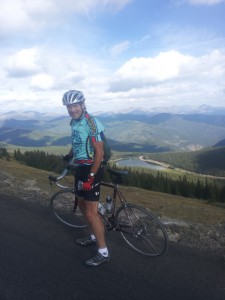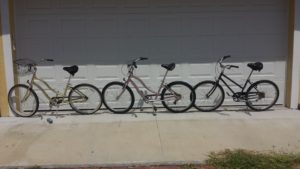Climbing Mt. Evans is a rite of passage for Colorado cyclists. It is not a steep climb but the road to Mt. Evans is the highest paved road in the U.S., topping at 14,000+ feet. I took the route from Evergreen, where we have a home. The climb from there is about 7,000 feet.

On the way to Mt. Evans
Admittedly, I was apprehensive about the climb. I didn’t want to die of a heart attack above the tree line, and I certainly didn’t want to have to call for help because I couldn’t make it. Most intimidating about the climb is the altitude. For the last 25 years I have lived at or near sea level. The past four months I’ve been in St. Petersburg, Florida, where the biggest climbs are over the various causeways. I’m in the best shape I’ve been in a while, thanks in large part to the members of the St. Pete Bicycle Club. Daily rides with some of the members, where I inevitably get dropped on the aggressive “second loop” of our morning rides, have made me stronger. But we’re at sea level (and sometimes under it during violent storms) and the closest hills are an hour away.
So I talked to folks in Colorado about the climb. One guy was trying to be encouraging but then said I should eat Clif Bar gels with caffeine because, “If you don’t have your food intake just right, you can hallucinate in the upper altitudes.” I could see myself prostrate on the road communing with the spirits. Others said to start early, especially in early September when, as one guy put it, “They get a lot of weather atop Mt. Evans.” I once had a backpacking buddy who used to love it when we “got weather” on the trail. Once was at 11,500 ft. when we were hit by a blizzard and then tried to hike through it to the top of the 14,000-ft. mountain. We didn’t succeed, but more importantly, we didn’t die what I and many others would think a foolish death. Starting early for the Mt. Evans climb, I was told, meant 6 a.m. Hell, I have a hard time making the group rides in St. Pete that start at 8:00 and I live only 10 minutes away. So I compromised: I would shoot for 7:00. I actually started the ride at 6:45. Those 45 minutes proved costly.
Over planning as I often do, I made a list of what I needed to bring. Warm clothes for the descent were first on the list. It is 20-25 degrees cooler at the top than in Evergreen, which meant that it would likely be in the 40’s this past Monday. I didn’t put on the list things I bring on every ride, so I got to the parking lot where I would start and discovered I left my riding sunglasses at the house, so my prescription glasses would have to do.
The climb went as well as I could expect. I had arrived in Colorado five days before and rode three times, one less than I had hoped. But I was encouraged that the altitude didn’t seem to be a big problem. I wasn’t fast up the hills but my heart rate stayed low and steady. I had actually planned on riding Tuesday, but learned on Sunday that the road would be closed for paving, so I pushed it up a day.
There were a couple of miles of dirt sections where workers were preparing to pave the next day, but they were packed and easy to navigate. After that, new pavement went up to Echo Lake at Squaw Pass, at 10,600 ft. above sea level and 18 miles from the start. I stopped by the lodge, which was small and quaint. I asked the woman there if she knew the conditions at the top. “You should be fine,” she said. “Just don’t dawdle up there and watch for weather.”
I then started up Mt. Evans Road. Within a few feet there is an entrance booth and learned that they no longer charge cyclists $3 to enter. I mentioned that at the very beginning of the climb a sign said Mt. Evans was open “to Summit Lake.” (The entire road closes for the winter around October 1.) “That’s right,” the woman in the booth said. “It’s five more miles to the top of the mountain. You can go up, but be aware, there’s nobody up there if you get in trouble or have weather.” (I had the sense that these people, like my hiking partner, loved “weather.”) She also asked if I had the proper clothing because “I see a lot of cyclists go up as people and come down as popsicles.”
The thought of being alone the last five miles gave me pause as I started the final 14 miles with about 3,500+ feet of climbing. The road is not in good shape. There are many cracks in the asphalt that jolt you as you cross them. But at 8 mph, they’re tolerable. In short order, I’m above the tree line, but the work keeps me comfortable as the temperature drops. The final switchbacks culminate at the parking lot. Turns out that I wasn’t alone. There were some park employees there as they were surveying the mountain goats that had developed some disease. One guy offered that he thought we cyclists were crazy. Another cyclist was also there and we take each other’s pictures. Only later do I find that my lens has fogged up and I look like I’m literally in the clouds. There were some moving in but at this point, no “weather.”
I figure the hard part is done. I’ll need to be careful on the descent, especially on the narrow Mt. Evans Road, but otherwise, I like descending so I was looking forward to it. Well, the climb may have been uneventful. The descent was anything but.
First off, those cracks were annoying at 8 mph. At 30-40 mph they were life threatening. I had to ride the brakes all the way down to Echo Lake. My neck and shoulders were tense and tightening with every curve in the road. My hands were cramping from squeezing the brake calipers. By the time I arrived at the lodge I was grateful for the smooth road ahead. Alas, the surface may have been smooth, but it wasn’t a smooth road ahead.
I had a little glitch in my shifting that I tried to fix my adjusting the rear derailleur. Whatever I did didn’t work. When I got back on the bike and shifted into the top gear, it locked up. My chain was jammed between the frame and the cassette. The chain had come off the derailleur pulleys. I thought I would have to call my brother to rescue me. But I got the chain back on. However, I couldn’t use the smallest cogs on the rear cassette. But then, it was all downhill. I’d be coasting most of the way. Again, I didn’t “coast” home.
It started to drizzle. I was 17 miles from the car. Then I heard thunder in the distance. Then it came closer. Then a thunderclap had me doing an involuntary bunny hop with the bike. I wasn’t sure whether my heart skipped or I had been given a heart shock by Mother Nature. It started to crackled in stereo, beginning on my right shoulder and over to the left. Now I was praying I wouldn’t get fried on the way down. It rained harder.
I then arrived at the section of the road being prepared for paving. The guys were still at it and had to limit traffic to one direction. The guy with the Stop/Slow sign said I couldn’t go because cars were coming up. Then the rain turned to pea and marble size hail. Lots of it.
I leaned up against a red van on the side of the road, hovering over my bike to protect it from the hail. By this time I’m soaked to the bone. The guy with the sign owned that van and said I could get in it but my bike couldn’t . I took refuge and hoped that my recently refinished frame would survive.
As I sat in the van I started to shiver, uncontrollably. I had hypothermia once before, on a camping trip with “weather.” The hail came down for about 15 minutes. When it let up, I told the guy I was going down even though it was still raining. There was another stretch of dirt road ahead. “It would only get muddier,” I said. He nodded, as I didn’t have much choice. My phone had died and I didn’t want to use the guy’s phone and have him witness my humiliation of calling my brother to rescue me. I was determined to get back on my own.
As I continued the descent I saw hail on the side on the road. It stuck to the trees and shrubs. I hit pavement again and was flying as fast as I thought safe as I was still shivering. Then I stopped in my tracks. As I turned a corner the road ahead was covered in hail. I pulled over. Could I wait until it melted? After a few minutes I realized that was fantasy. So I learned how to ride a bike on hailstones. Fortunately, the hail on the road was for only a few hundred yards. The last three miles were just wet. But I was very wet and still shivering.
I got to the car and threw the bike in the back and stripped of all clothes that wouldn’t get me arrested for indecent exposure, not that anybody was around in the rain.
The 5-mile ride home was an exercise in concentration. When you are shaking as hard as I was you don’t have all your faculties. I rode the first mile with the emergency brake still on. I passed an accident scene where two motorcycles were down among the hailstones.
When I got home I did what any ignorant ass would do: I jumped in a very hot shower. But afterwards, I was still shivering. I looked up online how to treat hypothermia. First rule, don’t try to heat up quickly—like taking a hot shower—as it can cause heart arrhythmia. I put on thermal underwear and a puff vest and shivered for another half hour before it subsided.
Of course, all this except for the derailleur problem I would have avoided if I left 45 minutes earlier.
I feel accomplished in achieving my Colorado rite of passage. And I feel damned lucky to live to tell about it.




